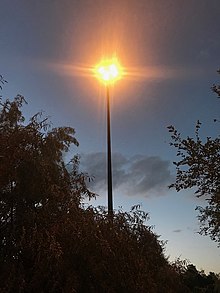






High-mast lighting is a tall pole with lighting attached to the top pointing towards the ground, usually but not always used to light a highway or recreational field. It is used at sites that require lighting over a large area. The pole that the lighting is mounted on is generally at least 30 m (98 ft) tall (under this height it is referred to as conventional lighting system), while the lighting consists of a luminaire ring surrounding the pole with one or several independent lighting fixtures mounted around it. Most units have four, six or eight lights in the ring, with three, five, ten, twelve and sixteen lights used in rarer instances. While most high-mast lights are high-pressure sodium, other lamp types such as mercury vapor, metal halide and LED, have also been used. Some units have the lighting surrounded by a circular shield to prevent or reduce light pollution or light trespass from affecting neighborhoods adjacent to the highway. Maintenance of these systems is done by lowering the luminaire ring from the mast head to the base using a winch and motor to the ground or at a height accessible by a cherry picker and located in areas to allow for easier access without disrupting traffic.
Development history
Prior to the 1960s, highway lighting was often provided by shorter (approx. 30 ft (9.1 m)) lighting poles with mercury vapor lamps. Advancements in high-mast illumination took place extensively in the mid-1960s in both Europe and North America. In 1966, the Texas Transportation Institute (TTI) installed a temporary 120 ft (37 m) tall high-mast tower at a highway interchange in Fort Worth, Texas with exceptional results. That same year, TTI and the Texas Highway Department installed twenty 100 ft (30 m) high-mast lighting towers at two adjacent interchanges on Loop 410 on the northeast side of San Antonio as part of a study to evaluate the benefits and techniques of various types of highway lighting. Each high-mast tower had ten 1,000 watt floodlights. Participants in the San Antonio Illumination Study traveled through the study corridor multiple times over two nights to observe and report impressions of the lighting, after which they were asked to complete a questionnaire about their experience and rate the different types of lighting. The surveys revealed that high-mast lighting was by far the preferred method of lighting.
By 1967, Europe was known to have high-mast illumination technology in practice. 1968 saw the first permanent US installations of high-mast illumination starting in Auburn, Washington south of Seattle. The first American towers were 100 ft (30 m) tall with a fixed-in-place lighting system that could not be lowered. A later project in 1968 featured a 150 ft (46 m) fixed-lighting tower on the Texas-Arkansas state line with two other 100 ft (30 m) fixed-lighting towers on either side of the state-border. By 1969/70, winch systems for the lighting systems were developed and several 175 ft (53 m) towers were installed in Dallas and Houston, followed soon thereafter by 200 ft (61 m) towers. Houston is believed to be the world's leading city of high-mast illumination along its freeways. Despite this, Belgium is considered to have the world's best-lit freeways.
Modern high-mast illumination towers typically range from 125 to 175 ft (38 to 53 m) tall and roughly 700 ft (210 m) in spacing.
Moonlight towers in Austin, Texas served as a major influence on TxDOT's design of some of the first modern high-mast lighting towers in the US during the 1960s and 1970s.
References
- ^ Lopez, Carlos A. (1 November 2003). "Section 4: Conventional vs. High Mast Lighting". Highway Illumination Manual. Archived from the original on 4 October 2011. Retrieved 31 October 2011.
- "Highway Lighting Unit Construction". Archived from the original on 3 April 2007. Retrieved 31 October 2011.
- "Let There Be Light" (PDF). Texas Highways. December 1966. Retrieved 14 December 2024.
- Slotboom, Erik (2003). Houston Freeways: A Historical and Visual Journey. www.HoustonFreeways.com: Oscar F. "Erik" Slotboom. pp. 76–83. ISBN 0-9741605-3-9.